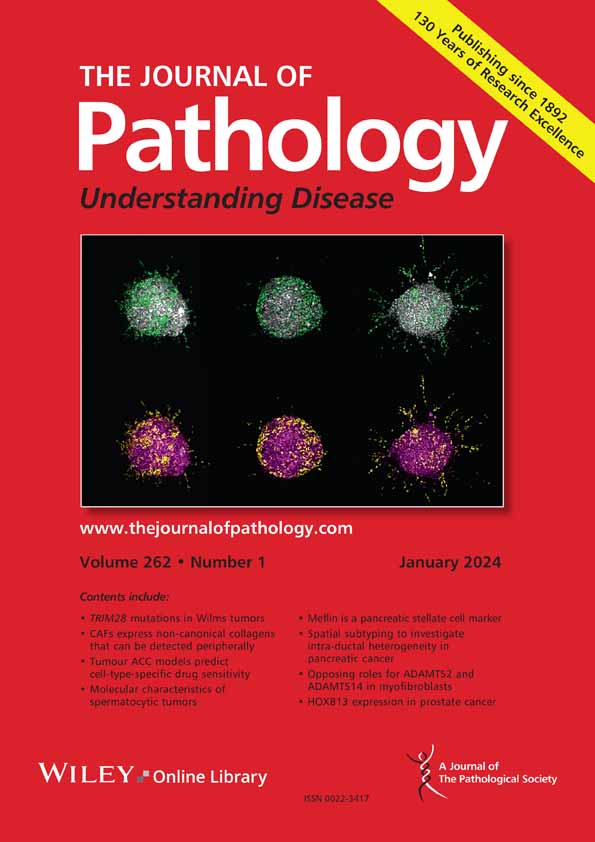Yingfeng Shi, Jinqing Li, Qin Zhong, Hui Chen, Xiaoyan Ma, Yan Hu, Yishu Wang, Daofang Jiang, Xun Zhou, Xialin Li, Shougang Zhuang, Na Liu
求助PDF
{"title":"Genetic deletion of histone deacetylase 6 prevents peritoneal fibrosis via suppression of heat shock protein 90 deacetylation","authors":"Yingfeng Shi, Jinqing Li, Qin Zhong, Hui Chen, Xiaoyan Ma, Yan Hu, Yishu Wang, Daofang Jiang, Xun Zhou, Xialin Li, Shougang Zhuang, Na Liu","doi":"10.1002/path.6436","DOIUrl":null,"url":null,"abstract":"<p>Peritoneal fibrosis (PF) is a serious complication contributing to ultrafiltration failure in patients undergoing peritoneal dialysis that currently lacks effective treatment strategies. Our recent studies highlighted the key role of histone deacetylase 6 (HDAC6) in the development of PF. To better understand the mechanisms underlying the involvement of HDAC6 in PF, we conducted <i>in vivo</i> experiments using <i>Hdac6</i> KO mice and <i>in vitro</i> studies using human peritoneal mesothelial cells (HPMCs). Our results demonstrated that <i>HDAC6</i> gene silencing improved PF and angiogenesis <i>in vivo</i> and altered pathological phenotypes <i>in vitro</i>. In <i>Hdac6</i> KO mice, the key pathways regulating extracellular matrix accumulation, angiogenesis, and secretion of inflammatory cytokines (including TGFB1/SMAD3, HIF-1α/VEGFR-2/MAPK3/MAPK1, and TLR4/NF-κB pathways) were inhibited. We also identified heat shock protein 90 (HSP90) as the substrate of HDAC6 in both PF mice and HPMCs and demonstrated that HDAC6 exerted its regulatory function in PF through the deacetylation of HSP90. Overall, our study provides novel insights into the critical role of the HDAC6-HSP90 interplay in PF using <i>Hdac6</i> KO mice. We identify HSP90 as an essential substrate through which HDAC6 exerts its function in PF, providing an experimental basis for the development of novel therapeutic strategies. © 2025 The Pathological Society of Great Britain and Ireland.</p>","PeriodicalId":232,"journal":{"name":"The Journal of Pathology","volume":"266 4-5","pages":"447-464"},"PeriodicalIF":5.2000,"publicationDate":"2025-06-20","publicationTypes":"Journal Article","fieldsOfStudy":null,"isOpenAccess":false,"openAccessPdf":"","citationCount":"0","resultStr":null,"platform":"Semanticscholar","paperid":null,"PeriodicalName":"The Journal of Pathology","FirstCategoryId":"3","ListUrlMain":"https://pathsocjournals.onlinelibrary.wiley.com/doi/10.1002/path.6436","RegionNum":2,"RegionCategory":"医学","ArticlePicture":[],"TitleCN":null,"AbstractTextCN":null,"PMCID":null,"EPubDate":"","PubModel":"","JCR":"Q1","JCRName":"ONCOLOGY","Score":null,"Total":0}
引用次数: 0
引用
批量引用
Abstract
Peritoneal fibrosis (PF) is a serious complication contributing to ultrafiltration failure in patients undergoing peritoneal dialysis that currently lacks effective treatment strategies. Our recent studies highlighted the key role of histone deacetylase 6 (HDAC6) in the development of PF. To better understand the mechanisms underlying the involvement of HDAC6 in PF, we conducted in vivo experiments using Hdac6 KO mice and in vitro studies using human peritoneal mesothelial cells (HPMCs). Our results demonstrated that HDAC6 gene silencing improved PF and angiogenesis in vivo and altered pathological phenotypes in vitro . In Hdac6 KO mice, the key pathways regulating extracellular matrix accumulation, angiogenesis, and secretion of inflammatory cytokines (including TGFB1/SMAD3, HIF-1α/VEGFR-2/MAPK3/MAPK1, and TLR4/NF-κB pathways) were inhibited. We also identified heat shock protein 90 (HSP90) as the substrate of HDAC6 in both PF mice and HPMCs and demonstrated that HDAC6 exerted its regulatory function in PF through the deacetylation of HSP90. Overall, our study provides novel insights into the critical role of the HDAC6-HSP90 interplay in PF using Hdac6 KO mice. We identify HSP90 as an essential substrate through which HDAC6 exerts its function in PF, providing an experimental basis for the development of novel therapeutic strategies. © 2025 The Pathological Society of Great Britain and Ireland.
组蛋白去乙酰化酶6的基因缺失通过抑制热休克蛋白90去乙酰化来防止腹膜纤维化。
腹膜纤维化(PF)是腹膜透析患者超滤功能衰竭的严重并发症,目前缺乏有效的治疗策略。我们最近的研究强调了组蛋白去乙酰化酶6 (HDAC6)在PF发展中的关键作用。为了更好地了解HDAC6参与PF的机制,我们使用HDAC6 KO小鼠进行了体内实验,并使用人腹膜间皮细胞(hpmc)进行了体外研究。我们的研究结果表明,HDAC6基因沉默改善了体内PF和血管生成,并改变了体外病理表型。在Hdac6 KO小鼠中,调节细胞外基质积累、血管生成和炎症因子分泌的关键通路(包括TGFB1/SMAD3、HIF-1α/VEGFR-2/MAPK3/MAPK1和TLR4/NF-κB通路)被抑制。我们还在PF小鼠和hpmc中发现热休克蛋白90 (HSP90)是HDAC6的底物,并证明HDAC6通过HSP90的去乙酰化在PF中发挥其调节作用。总的来说,我们的研究为Hdac6 - hsp90相互作用在PF中的关键作用提供了新的见解。我们发现HSP90是HDAC6在PF中发挥作用的重要底物,为开发新的治疗策略提供了实验基础。©2025英国和爱尔兰病理学会。
本文章由计算机程序翻译,如有差异,请以英文原文为准。



 求助内容:
求助内容: 应助结果提醒方式:
应助结果提醒方式:


